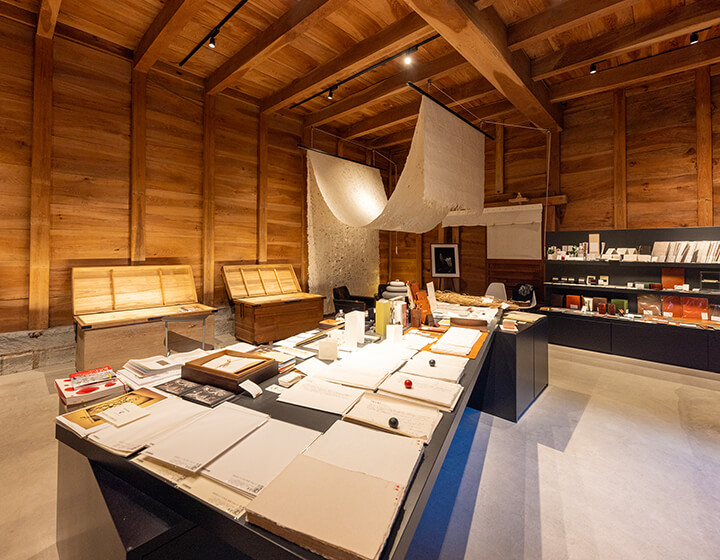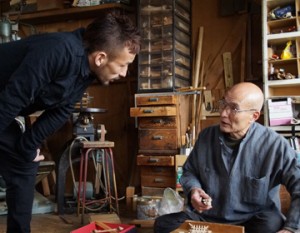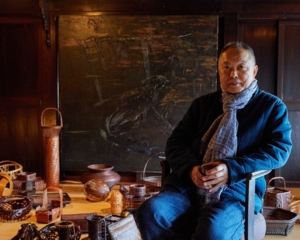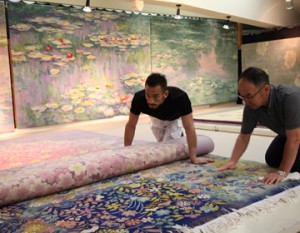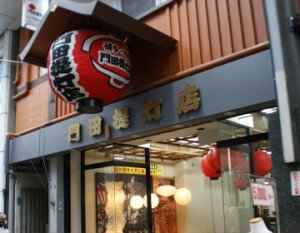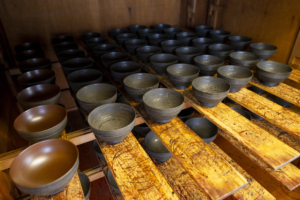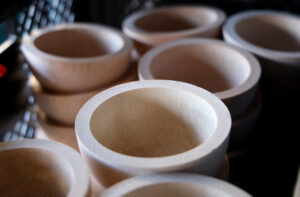The Imadate area, located on the east side of Echizen City in central Fukui Prefecture, is a major production center of Echizen washi with a history of 1,500 years and is home to Okata Shrine and Otaki Shrine, the only shrines in the country dedicated to the god of paper. Yoshinao Sugihara, who took over the 150-year-old washi wholesaler Sugihara Shoten in this “village of washi,” is bringing a new style to the world of washi by connecting producers and modern needs with ideas and energy.
The Challenge of a 150-Year-Old Washi Wholesaler
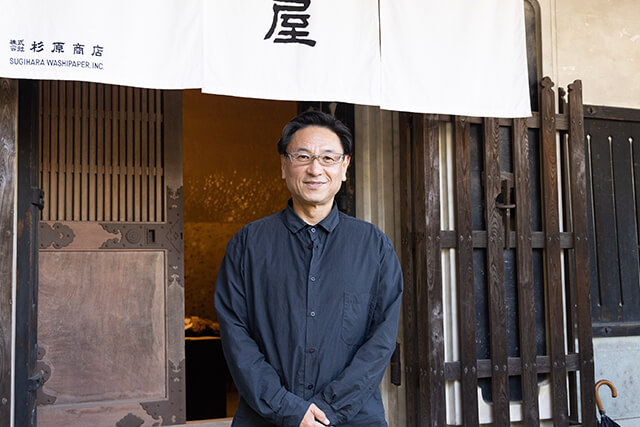
Mr. Sugihara is the 10th generation of a long-established washi wholesaler and calls himself a “washi sommelier. As a wholesaler, his work is not limited to purchasing washi from producers and wholesaling it. He also plans and sells large-format washi as interior decorations for spaces, including products that reconstruct washi in response to the changing times. The company’s connections with local washi producers make it possible to develop innovative products. Each producer has its own specialty. They are asked to make use of these to meet the needs of modern consumers and clients in Japan and abroad. It is Mr. Sugihara who wields the tact. Like a sommelier who selects wines according to taste.
Making the most of washi compatible with home-use printers
Sugihara Shoten now sells washi paper worldwide. Mr. Sugihara’s path to prosperity has not been a smooth one.
In 1988, when Mr. Sugihara returned to his hometown at the age of 26 after working for Kozu Sangyo, a washi wholesaler that had been in business for nearly 370 years, and joined Sugihara Shoten, the washi industry was facing a period of decline. Demand for fusuma paper, which had been rising steadily during the high-growth period of the Japanese economy, had plummeted due to the westernization of housing and the decrease in the number of Japanese-style rooms. Echizen washi, which had previously excelled at fusuma paper, suffered a major blow. Sugihara, who was concerned about the survival of the Echizen washi industry, decided that the survival of Echizen washi would depend on the survival of the washi producing region, and he decided to establish Sugihara Shoten. With this sense of crisis, Mr. Sugihara began to develop washi products in response to the changing times.
The result was “habutae paper,” which can be printed on a home printer. Washi paper is originally designed so that characters will not bleed through when written on with ink. However, it is a fact that the custom of writing characters with ink on a daily basis is disappearing, except for calligraphers. Habutae paper was created by applying a device to Japanese paper to prevent blotting even with ink. The variation in thickness was also groundbreaking for washi. This washi, named after a textile representative of Fukui Prefecture, once known as the “Habutae Kingdom,” was a hit, perfectly capturing the changes of the times with the widespread use of printers.
Hand-rolled sheets of washi paper called “Chigitate Meisho” (tear-off business cards)
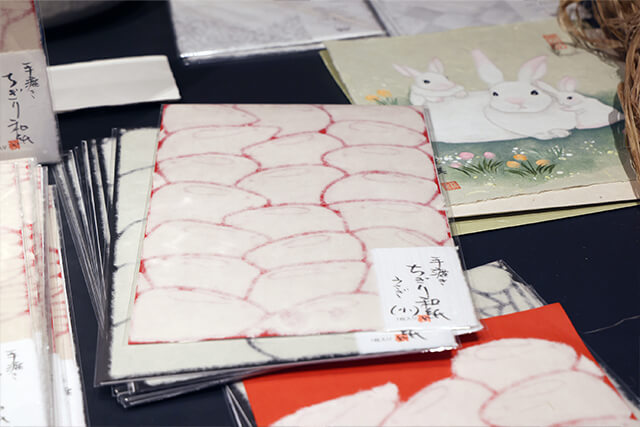
After feeling the pressure to develop new washi products, Mr. Sugihara turned his attention to a use for paper that would not become obsolete despite the advance of digitalization. It was business cards, which are indispensable for face-to-face business. Instead of cutting the paper apart from the beginning, he folded a sheet of Japanese paper into a business card by tearing it off by hand. The name of the new product is “Tear-off business cards. Even the edges, which have been torn off and fluffed up, have a washi-like appearance. The traditional “sukashi” technique was adopted in the development of this product, and the folded part is finished with sukashi to make it easy to tear off by hand. Tear-off business cards” have been introduced on TV and other media, and have been a big hit. Today, the company produces not only business cards, but also sheets of washi with motifs of animals, flowers, etc. The “Tchigitte” series has been used for a variety of purposes. The “Chigitte” series offers a wide range of variations.
Lacquer on Washi. A New Encounter of Traditional Crafts
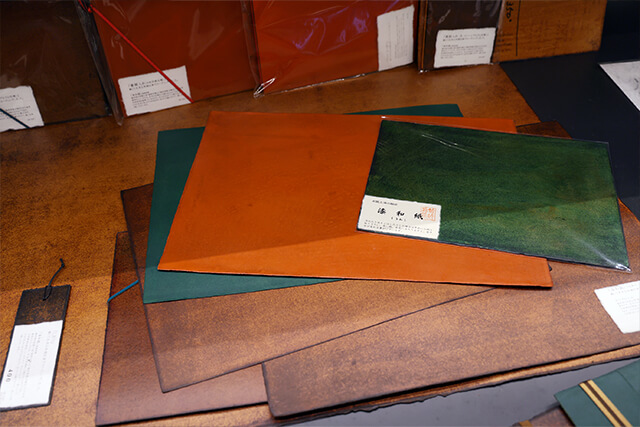
Next, Mr. Sugihara planned to collaborate with traditional crafts. In the Echizen City area of Fukui Prefecture, where Echizen Washi paper is produced, a variety of other traditional crafts are also thriving. One of them is lacquer, which is essential for Echizen lacquerware, and we wondered if we could use it in our washi products. The result is “Urushi Washi. The result of a trial-and-error process, Urushi-Washi has the appeal of a leathery look that has been used for a long time, created by the combination of Japanese paper and lacquer. The lightness of the paper is retained, while the water resistance is enhanced by the lacquer coating. Soon after its commercialization, Urushi-Washi won the grand prize of “DESIGN WAVE FUKUI,” which honors products with excellent design in Fukui Prefecture.
Expanding Washi’s Sales Channels and Possibilities
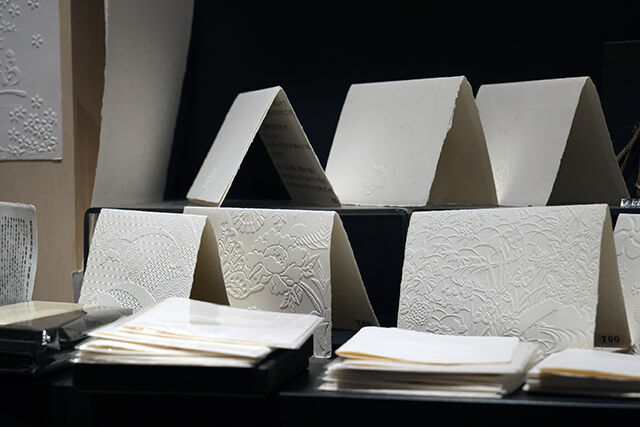
Habutae Washi,” “Tear-off Business Cards,” and “Lacquer Washi. All of these products are products that have successfully revived a tradition that has lived on in the region and adapted it to modern needs. However, there were many difficulties when they were first launched. The more innovative a product is, the longer it takes for the world to accept it. Mr. Sugihara’s product was no exception, and he was particularly persistent in his discussions with producers. When he consulted with his existing customers, he was told that they were interested in his interesting product but did not know how to sell it. The same was true for Mr. Sugihara himself.
He decided that he had no choice but to do it himself. Mr. Sugihara personally went to major retailers such as Tokyu Hands, with whom he had no previous business relationship, to develop sales channels. He made a number of innovations to make it easier for retailers to sell his products, such as cutting Japanese paper into A4 size, and gradually gained acceptance.
A Fateful Encounter at an Exhibition
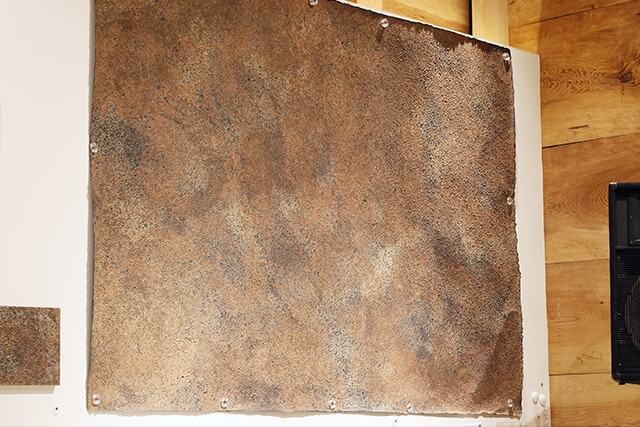
Sugihara Shoten is proud that it was able to develop sales channels to some extent and create products that connect washi to consumers. This brought a future to Sugihara Shoten. However, when I looked at the entire washi production area, “washi-no-Sato,” I wondered if I could do something more. For a long time, he remained conflicted.
Then came a fateful encounter.
Sugihara Shoten was also exhibiting at a “craft exhibition” held in Fukui Prefecture. It was a routine stall every year, but a prominent design consultant I met at the exhibition had this to say to me. Do you know that Japanese paper is in demand in architecture?”
Washi paper in architecture? I had no idea what he meant. When I was at a loss for words, the consultant told me to attend the exhibition. Feeling something like fate, Mr. Sugihara decided to exhibit at IPEC, an international exhibition on interior design held at Tokyo Big Sight, despite his misgivings.
This was the catalyst for a leap forward. He was the first in the Japanese paper industry to exhibit there, and received an Encouragement Award. In addition, Sugihara Shoten received an order for a tremendous amount of washi paper to be used as a building material for Roppongi Hills in Tokyo, which was under construction at the time. Mr. Sugihara says, “I went to the exhibition.
We went to exhibitions, made connections with designers and planners, and started going abroad. What surprised me was their appreciation of the beauty of washi. Washi as a construction material is extraordinary in terms of both unit price and amount used. That is when I rediscovered the high potential of Echizen washi.
All for the sake of enhancing the value of washi

Echizen Washi as a construction material, for which Mr. Sugihara paved the way, is gaining further recognition. Echizen washi was used for the walls and pillars of the Lyon City Hall in France, the Tokyo 2020 Olympic Stadium, the lounge at New Chitose Airport, the entrance to Mita Hospital in Tokyo, and the new facility “Eshikoto ” of the Kuroryu Sake Brewery, one of Fukui’s representative sake breweries, where Sugihara Shoten’s Echizen washi was used as restaurant wallpaper. Echizen Washi, handled by Sugihara Shoten, was used as the restaurant’s wallpaper.
Encounters with People through Washi
Sugihara Shoten has continued to innovate as a wholesaler of Echizen washi. While the distribution of this paper has fallen into disuse due to the shrinkage of its existing uses, the company has created new demand through sales at major retailers and in the form of construction materials.
The catalyst and driving force behind this challenge has been the relationships with people he meets wherever he goes. Through Echizen Washi, I want to create a “place” where people can engage with each other in a richer way. I believe that there will be further innovations that will be created through the effects of these places.
A 100-year-old storehouse converted into a washi gallery
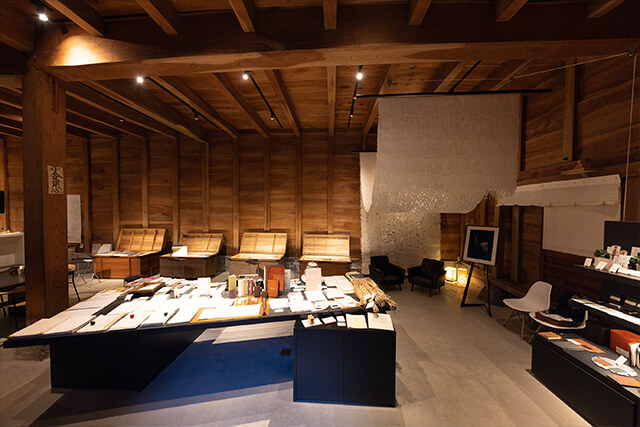
The fruit of Mr. Sugihara’s vision is “Washi Shop,” a washi gallery opened on the premises of Sugihara Shoten. The Wagamiya, which was renovated from a 100-year-old warehouse adjacent to the company’s premises, exhibits washi works as interior decorations and art, such as lighting fixtures and vessels, as well as samples of kozo, mitsumata, and gampi, the raw materials used to make washi, and the paper from which they are made. A huge tapestry of washi hanging from the ceiling is also a highlight. Washi items such as “Habutae Washi,” “Tear-off Business Cards,” and “Lacquer Washi” are also available for purchase.
Mr. Sugihara welcomes visitors with hand-brewed coffee and responds to clients’ requests to actually touch the washi and listen to their stories. He is truly a sommelier of washi as he searches for the best proposal while explaining the historical background and transition of washi.
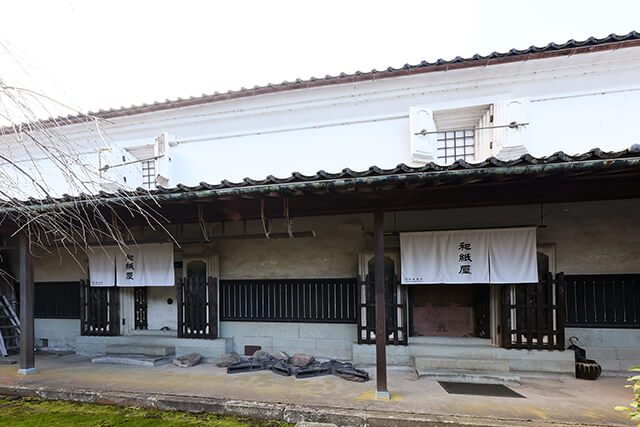
A deserted century-old warehouse was transformed into a place for people to gather through the use of washi. Washi has the power to connect people with each other, and will surely survive,” says Sugihara.
I will listen to various people and try everything through trial and error. In the process, I hope to find something new.
Sugihara Shoten will continue to connect people with Echizen washi and weave a new tradition of washi.



